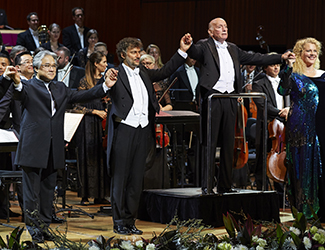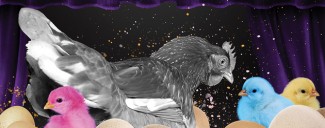Concert Review: True Romantics /Australian Chamber Choir

True Romantics
Australian Chamber Choir
Art Gallery of NSW
16 September, 2018
Beneath the artworks of some of Australia’s greatest painters, the Melbourne based Australian Chamber Choir directed by Douglas Lawrence OAM, presented its program True Romantics, at the Art Gallery of New South Wales as part of its Resonate concert series.
Moving beyond the conventional bounds of the Romantic period, the program featured music by Monteverdi, Brahms, Elgar, Barber, Ravel and Australian composers Allan Holley and Brenton Broadstock.
Musical and social agendas combined in the choir’s opening item, when, breaking with chronological convention, they performed Brahms’ motet ‘Warum ist das Licht gegeben, opus 74 no. 1 (Why is light cast upon the sorrowful?) It was an acknowledgement of RU OK? Day observed last week, as well as noting Brahms’ disposition as a “severely” melancholic person. The music of J S Bach is often an integral part of the ACC’s programming. Although there were no works by Bach in this concert, the spirit of the great man was undeniably present in this motet, published in 1878 with a dedication to the great Bach scholar, Philipp Spitta.
It is a work requiring serious choral heft. The ensemble of just 18 voices in four parts, created a sombre mood, moving to a more jubilant six-part canon Lasset uns unser Her. There were more contrapuntal devices to explore, before closing with a quintessential four-part chorale. The fugal themes were skilfully coloured in light and shade; the vocal blend was seamless with dynamics, diction, scholarly phrasing and finely honed ensemble skills adding to a rare and beautifully focussed sound.
Back to the origins of choral music and choral soloists stepped out from the ranks for two madrigals by Monteverdi, Lasciatemi morire and Si Ch’io vorrei morire, followed by the entire ensemble singing a third madrigal, the lightly tripping Cruda Amarilli. It is quite a contrast to move from the rich romantic sound of Brahms to Monteverdi’s brighter tone and more agile phrasing. However, embracing the contrasting themes of love and death, the transformation was achieved effortlessly and with conviction.
The choral transcriptions of Samuel Barber’s Agnus Dei and Edward Elgar’s Lux Aeterna share a history of having been written for stringed instruments before their choral incarnations at the hands of their composers. Setting the text of the Latin Mass, they are often programmed together, although this time, the ACC deftly paired each of these with another item by their composer, specifically written for voices. Barber’s Agnus Dei was originally the Adagio from his String Quartet opus 11, transcribed by him for 8 voices in 1967. Elgar’s Lux Aeterna started life as Nimrod from the Engima Variations. The arrangement adopted by the ACC in this concert was by choral alto Elizabeth Anderson.
Both are luscious pieces of music, more easily played, as intended, on stringed instruments, than they are sung. Barber’s Agnus Dei requires a sustained bloom through stepwise ascending and descending passages reaching a shattering climax. More recently adapted to funereal settings, it can veer towards the maudlin. However, Douglas Lawrence’s fluid tempo with the floated timbre achieved by the singers ensured a gracefulness and optimism in this cry for mercy.
Elgar’s Lux Aeterna is built on vocally challenging arpeggiated phrases requiring dramatic changes in vocal register and unerring pitch. In both selections, the ensemble delivered elegant lines that spun into eternity, whispered phrases that built to anguished cries and fully realised the power, glory and reverence of the music.
As for the companion pieces, Barber’s Twelfth Night is a Christmas carol to words by the English poet Laurie Lee. Tonally challenging, the ensemble navigated securely through this canticle. Elgar’s As Torrents in Summer from his now forgotten cantata King Olaf, with words by Longfellow was gently expressed by the singers, and pointed to the breaking of a drought – a topic close to hearts and minds and reflected in some of the landscapes surrounding us.
In the presence of composer Allan Holley (b 1954), the ACC sang his And the Rain with text by poet Mark Tredinnick, who was also present. Another musical commentary on social matters, Holley uses clusters of chords and vivid word-painting to convey his message. At times dissonant, the piece ends with a distinct sense of tonality radiating a sense of closure after discordant doubts about the future.
Brenton Broadstock’s I Had a Dream is an introspective homage to the late composer, Michael Easton leading to the music of Ravel and his Trois Chansons modelled on Renaissance chanson, using folk-like themes and infectious tunes to words which he wrote himself. The Trois Chansons is a gorgeous trio of a capella songs, sadly, the only ones he wrote for this genre. The ensemble drew a playful portrait of Nicolette with her teasing, wry humour; the tender bereavement of Trois beaux oiseaux du Paradis was exquisitely sung by soprano Amelia Jones and tenor Anish Nair, with the rest of the ensemble providing secure harmonic support; and Ronde, a dark, tongue-twisting romp portraying a cast of imaginary creatures from childhood stories.
As a generous encore (one hopes they made their late-night Melbourne flight!), the ACC performed Rheinberger’s six-part Abendlied (Evening Song) – an appropriate end to the soiree.
The Australian Chamber Choir with its mastery of numerous styles and the languages of song, combined with exemplary vocal technique and ensemble skills, creates a glorious sound. Return visits and perhaps even collaborations with Sydney choral ensembles would be very welcome.
Shamistha de Soysa for SoundsLikeSydney©







